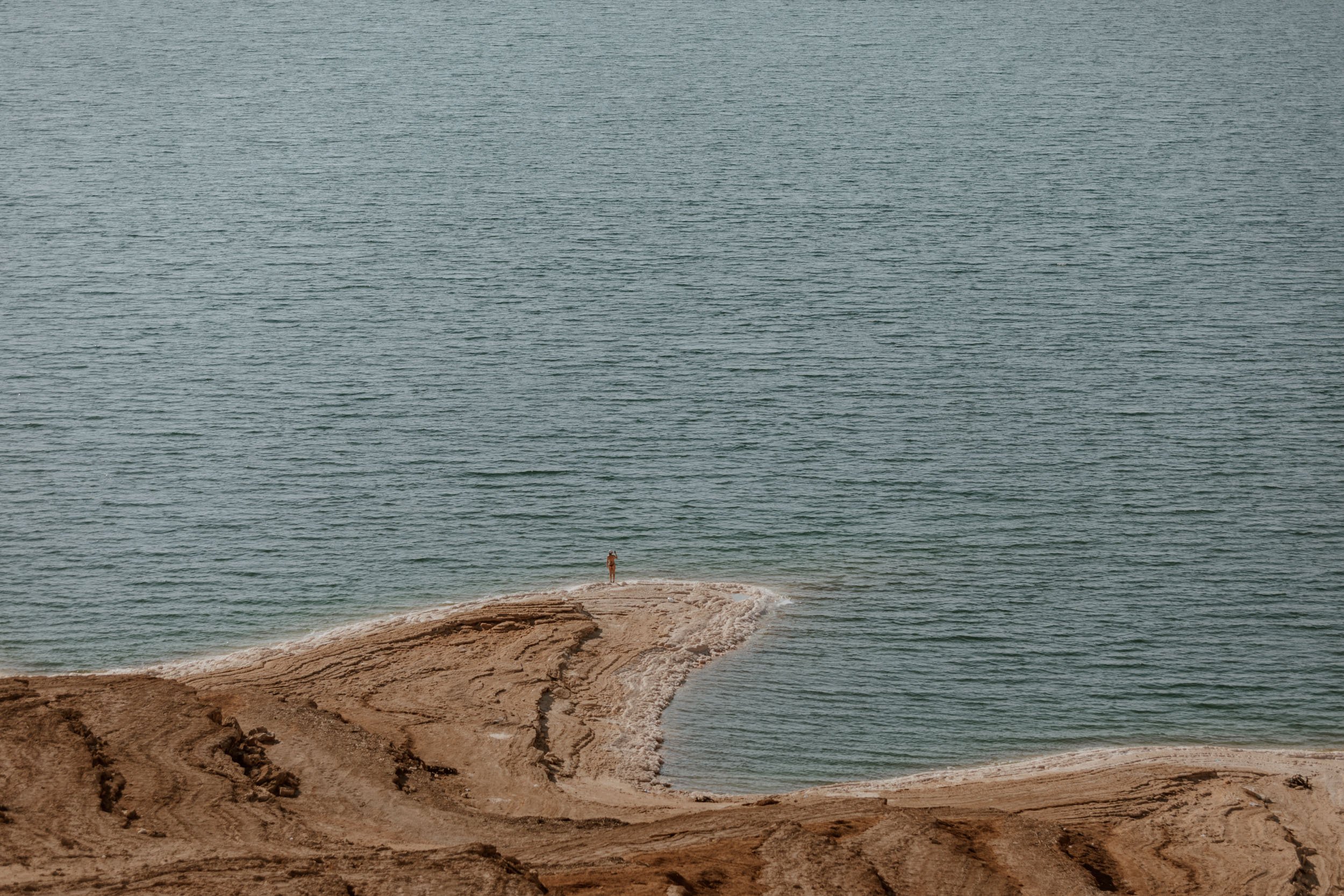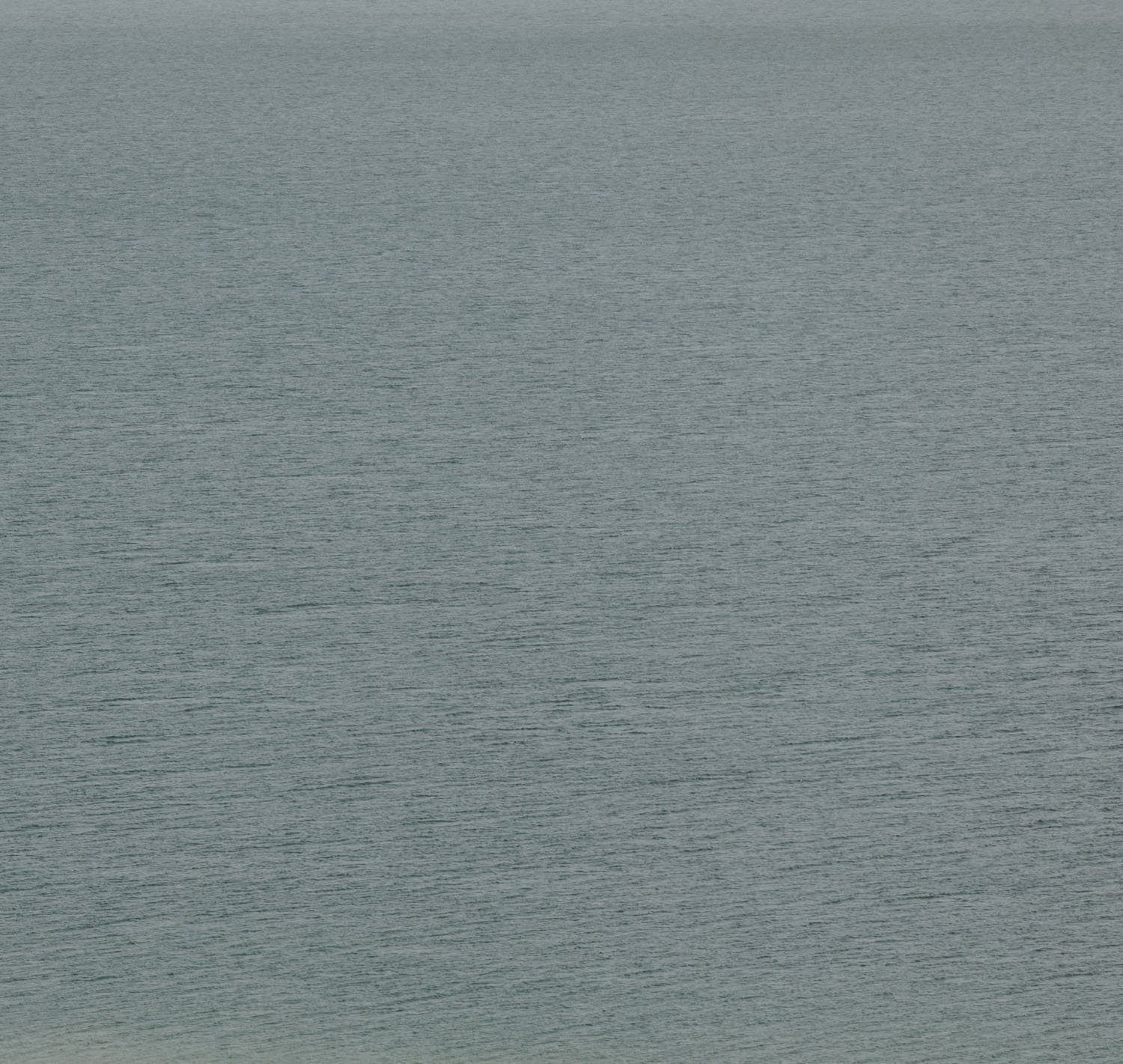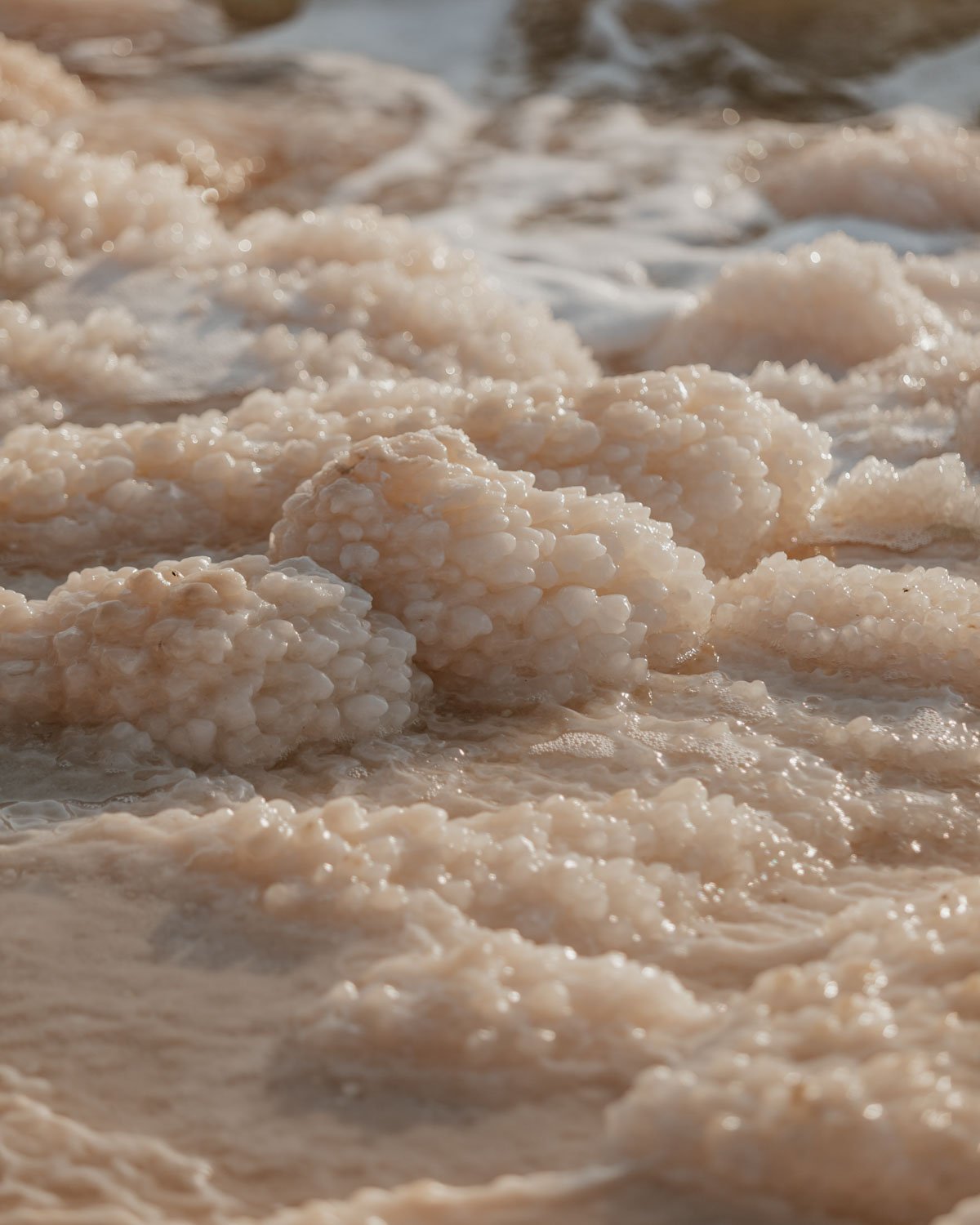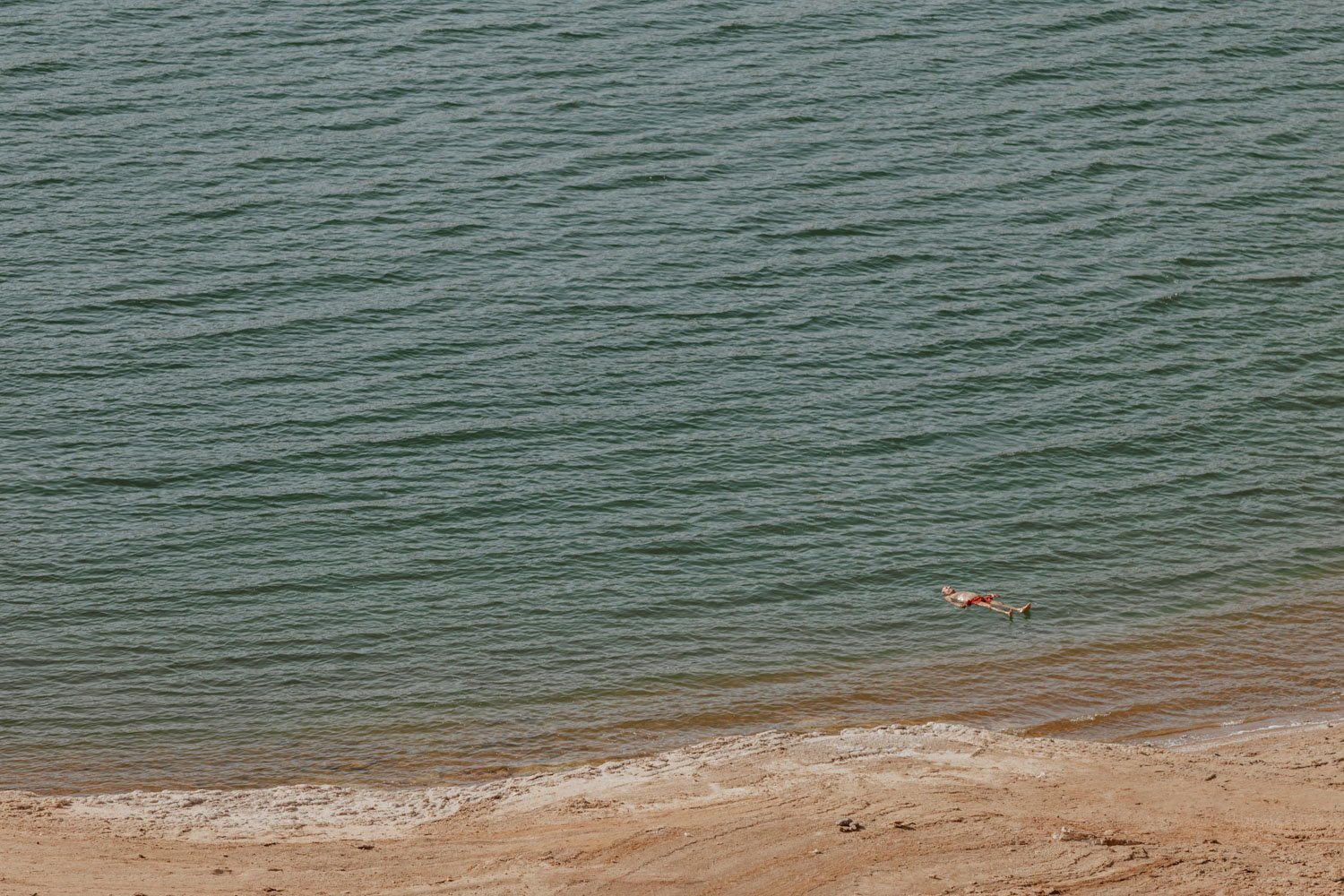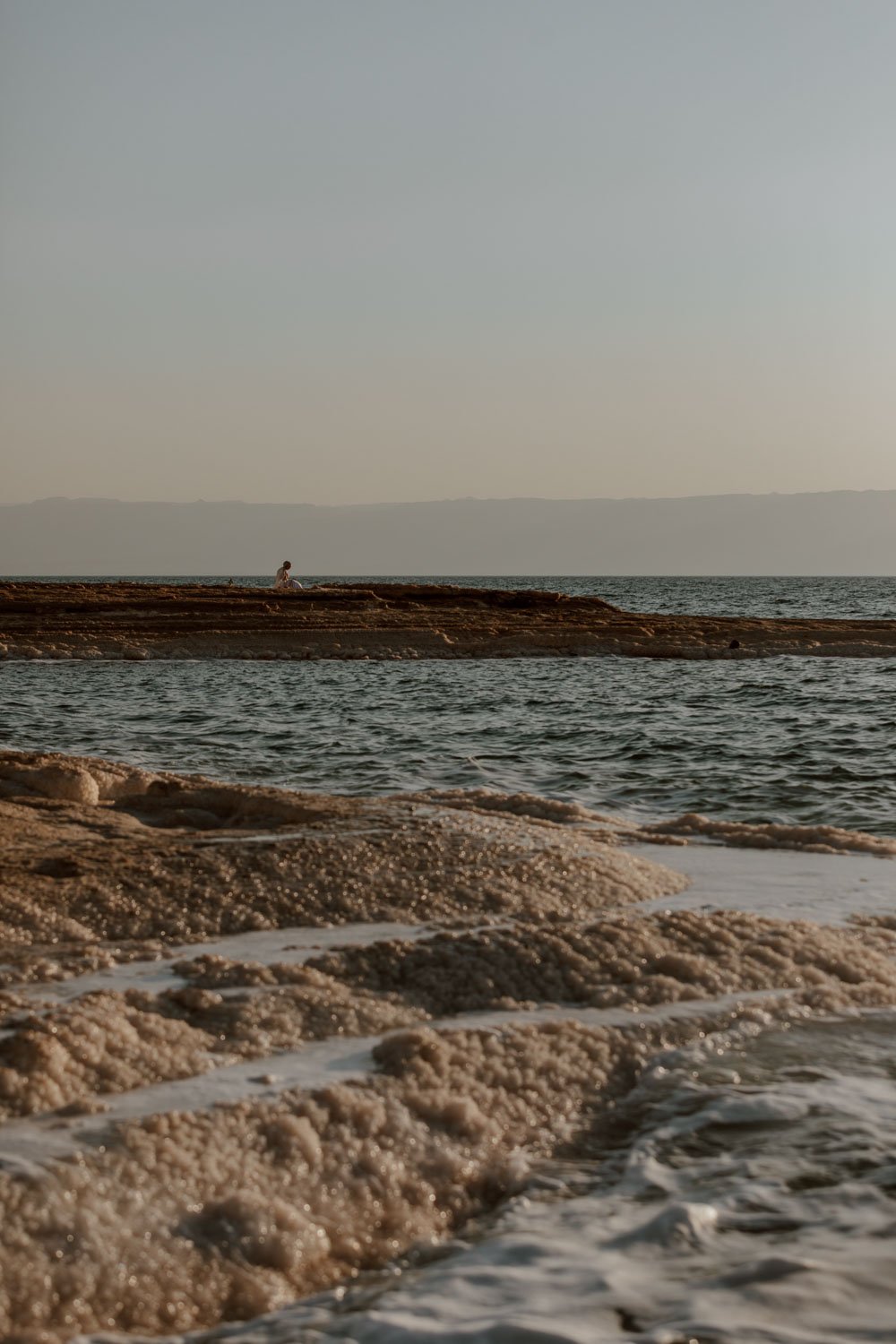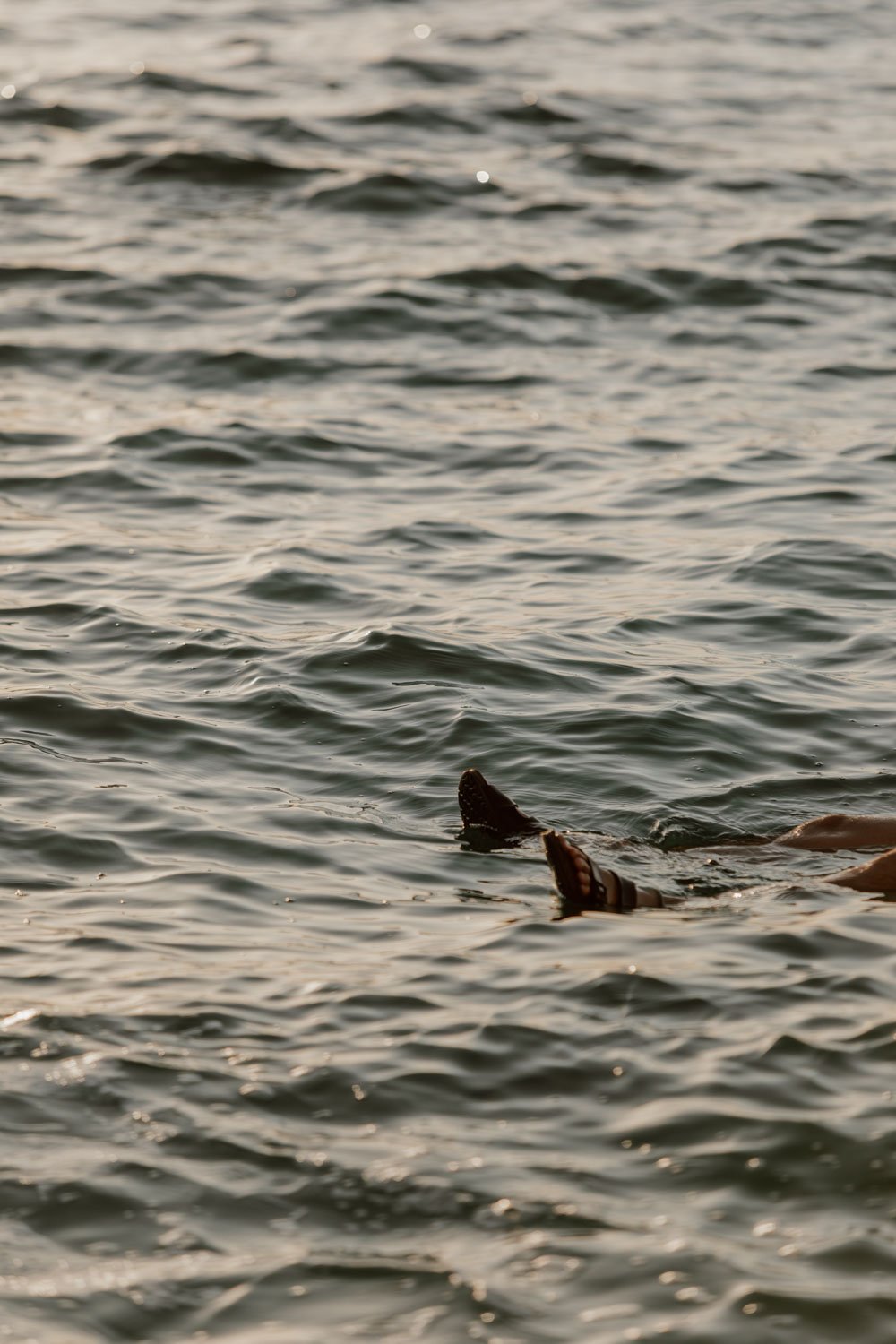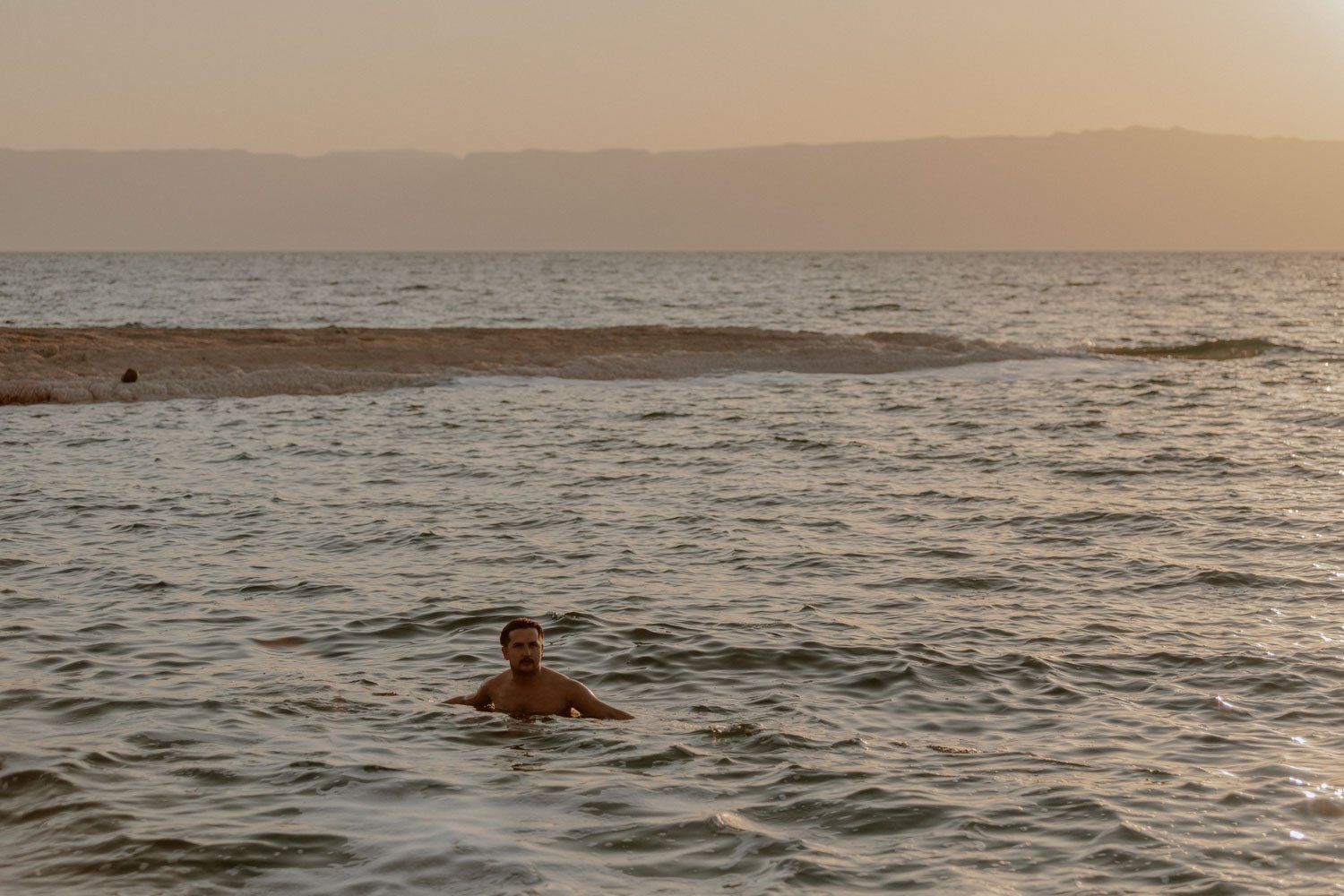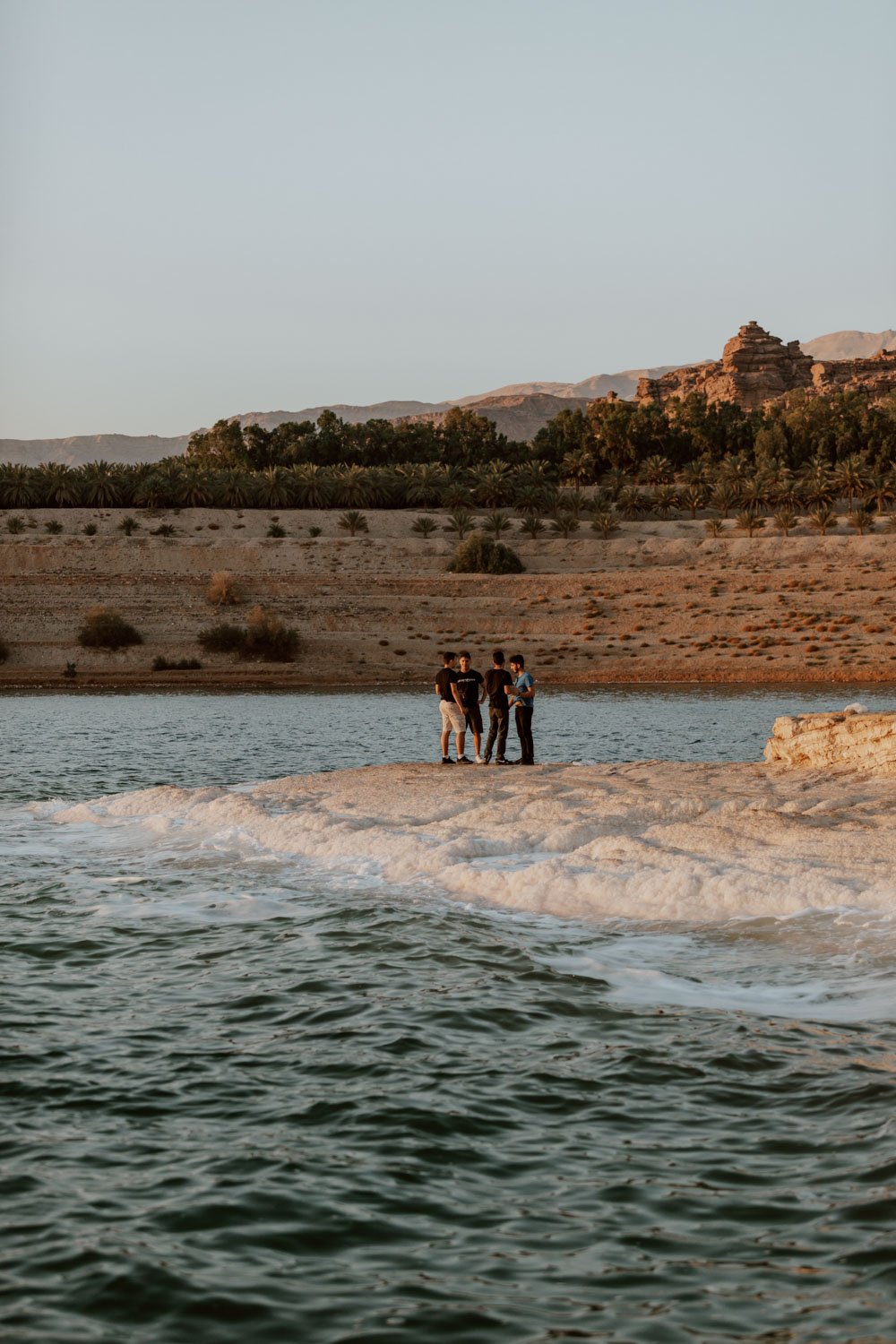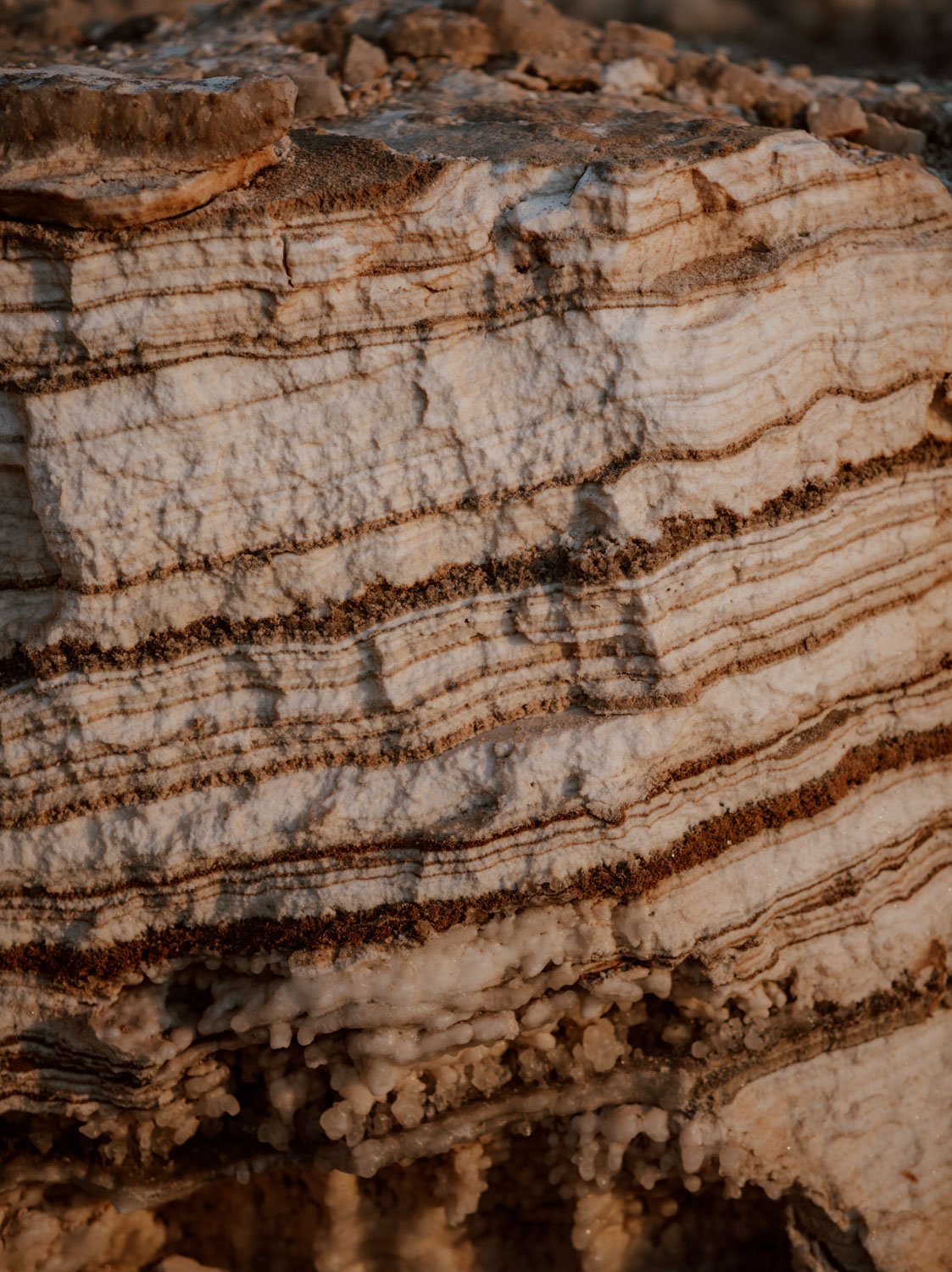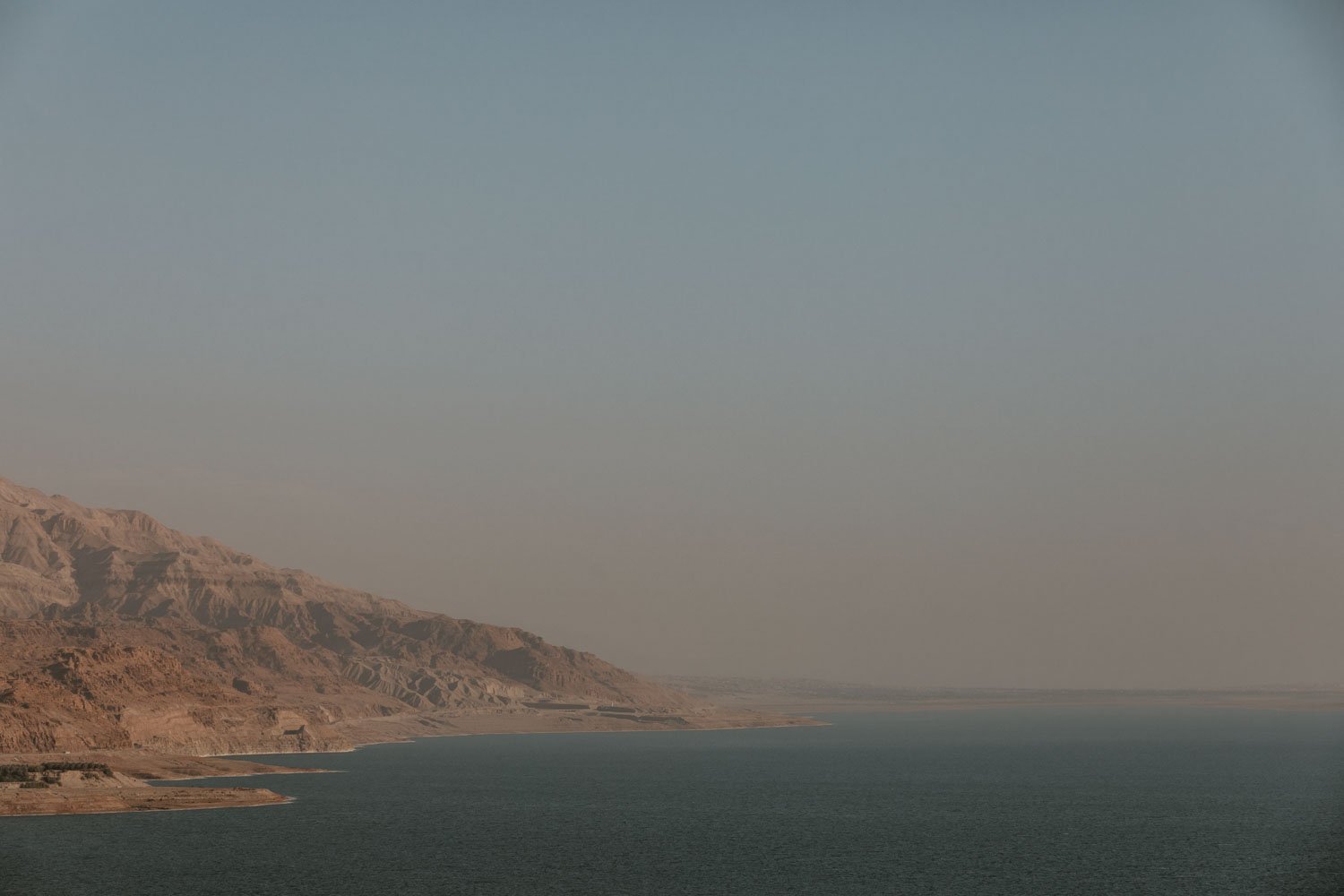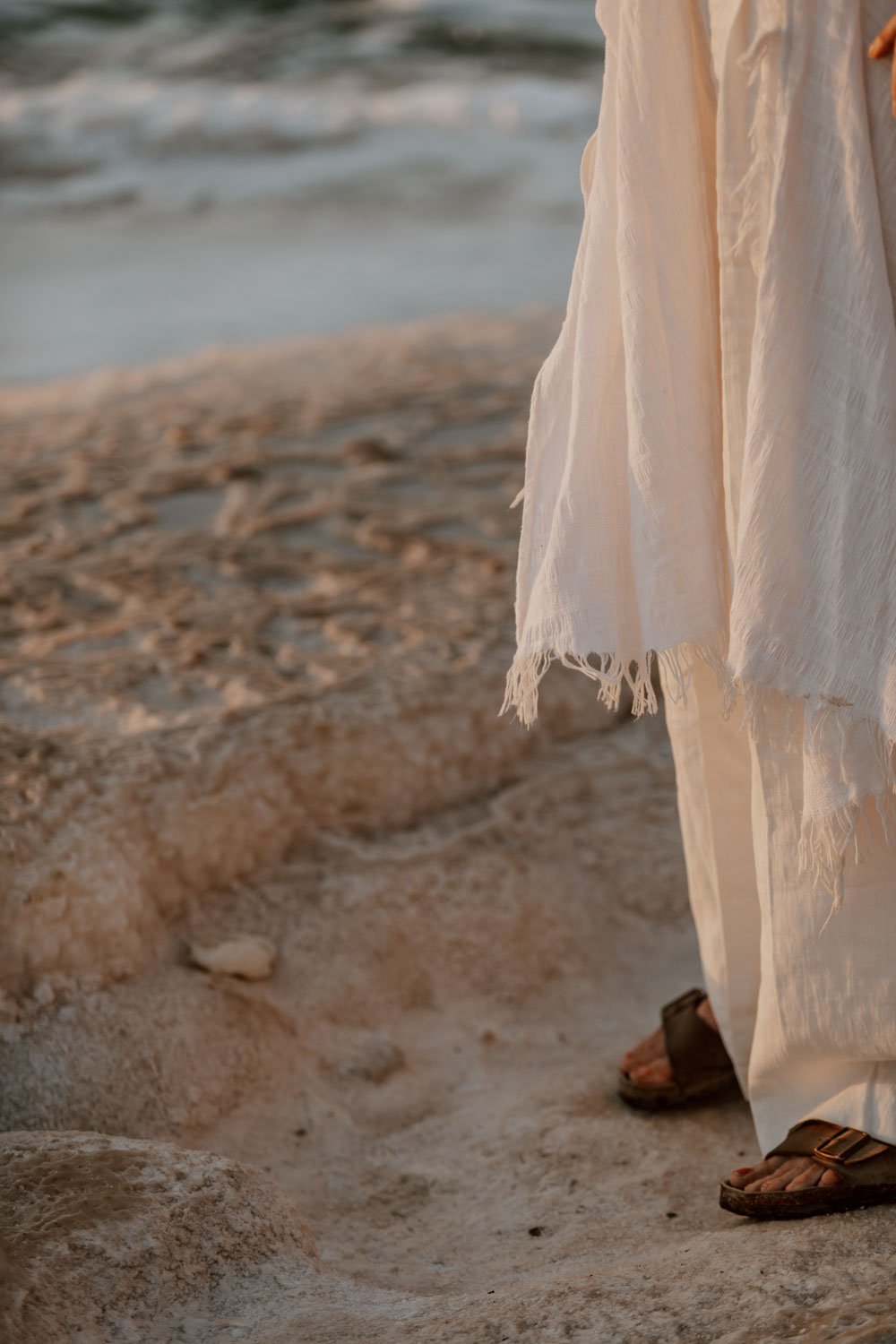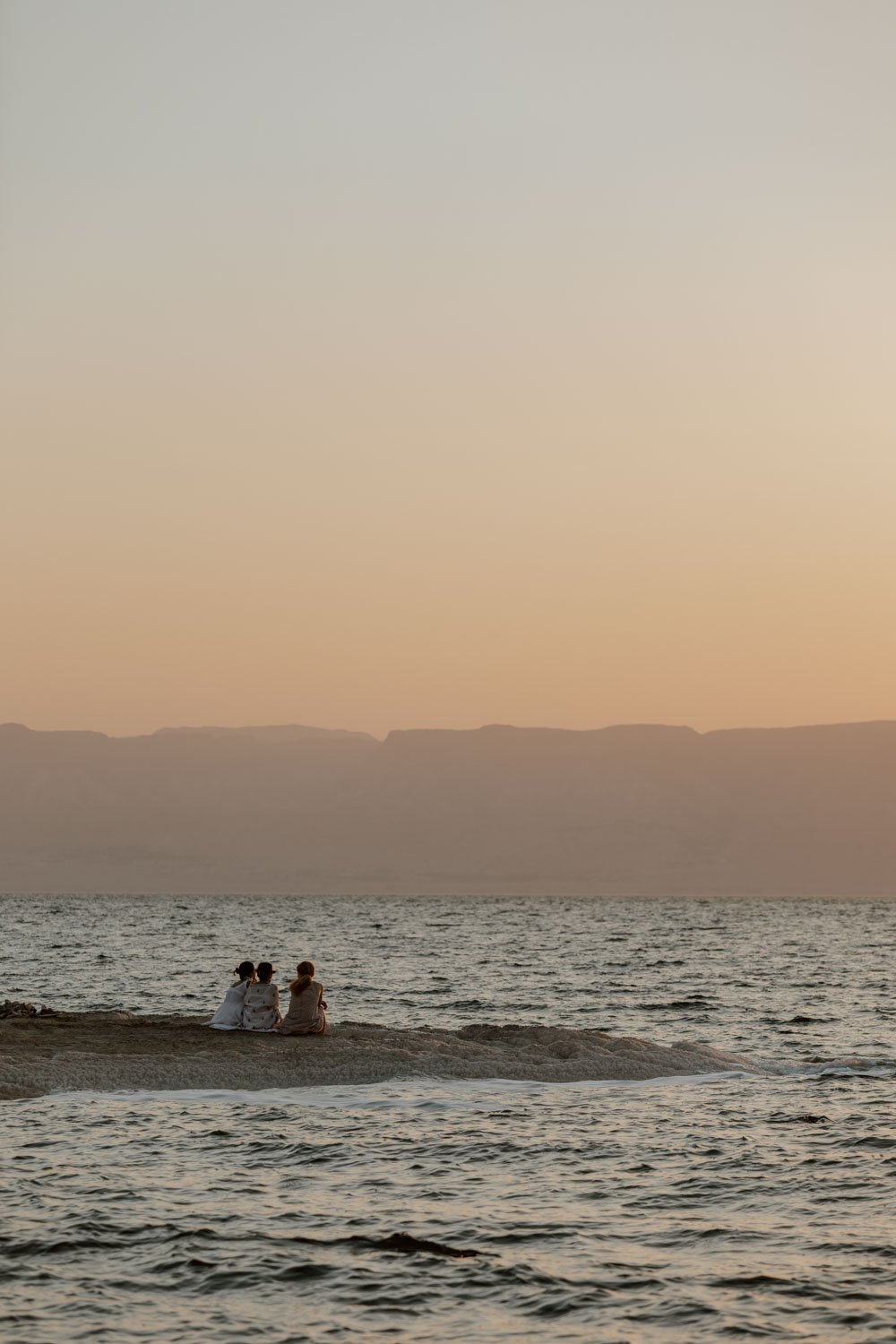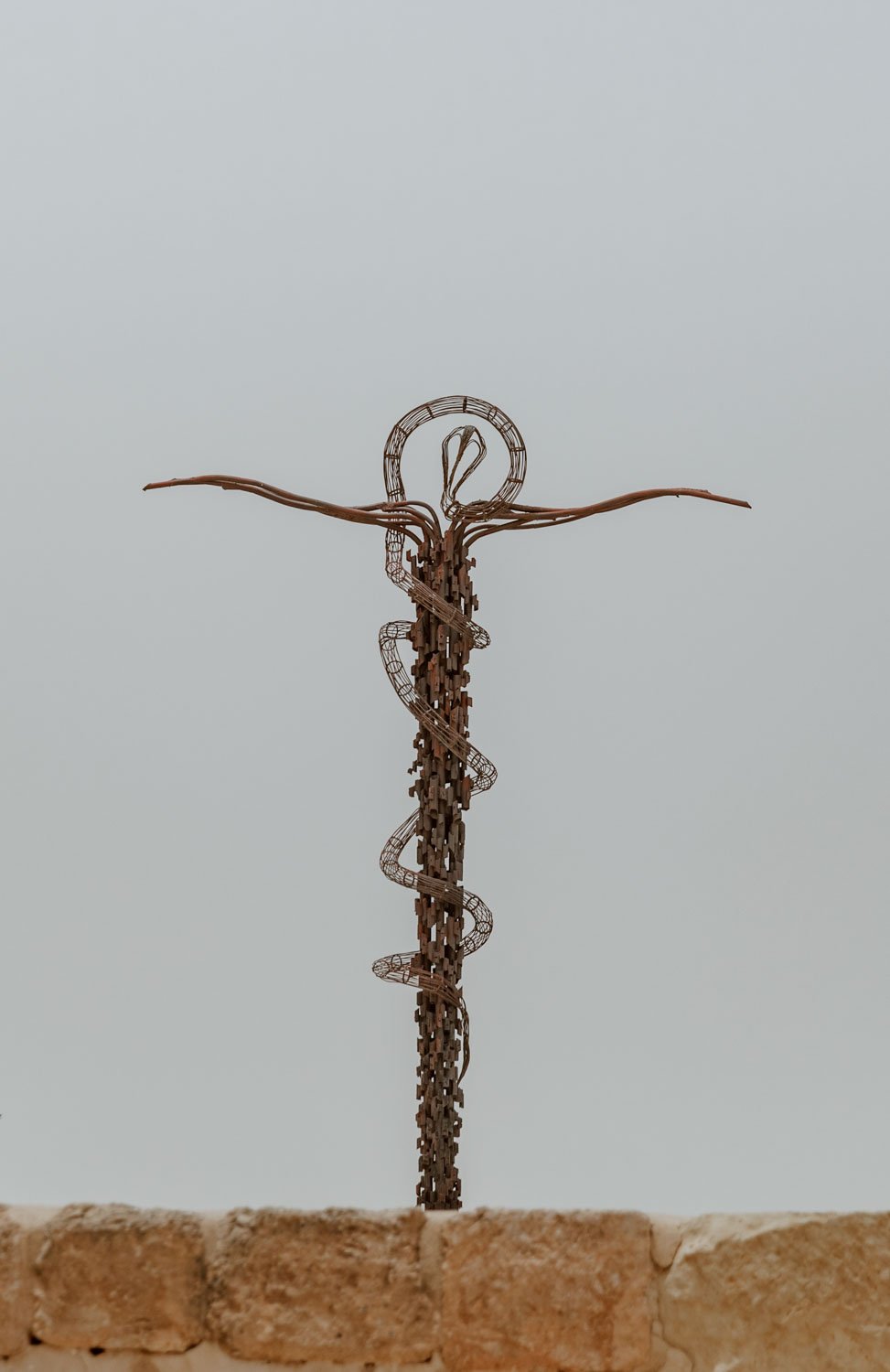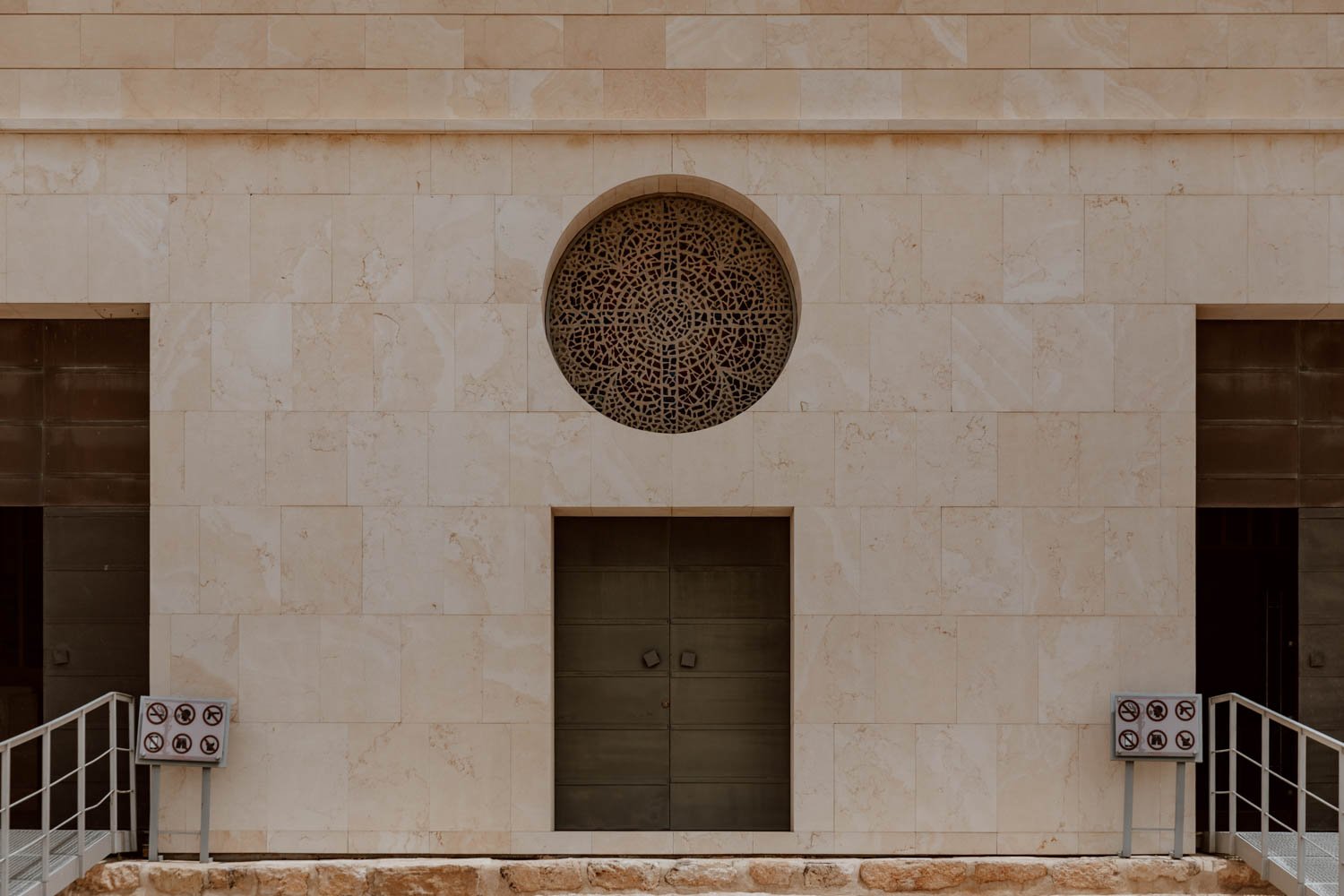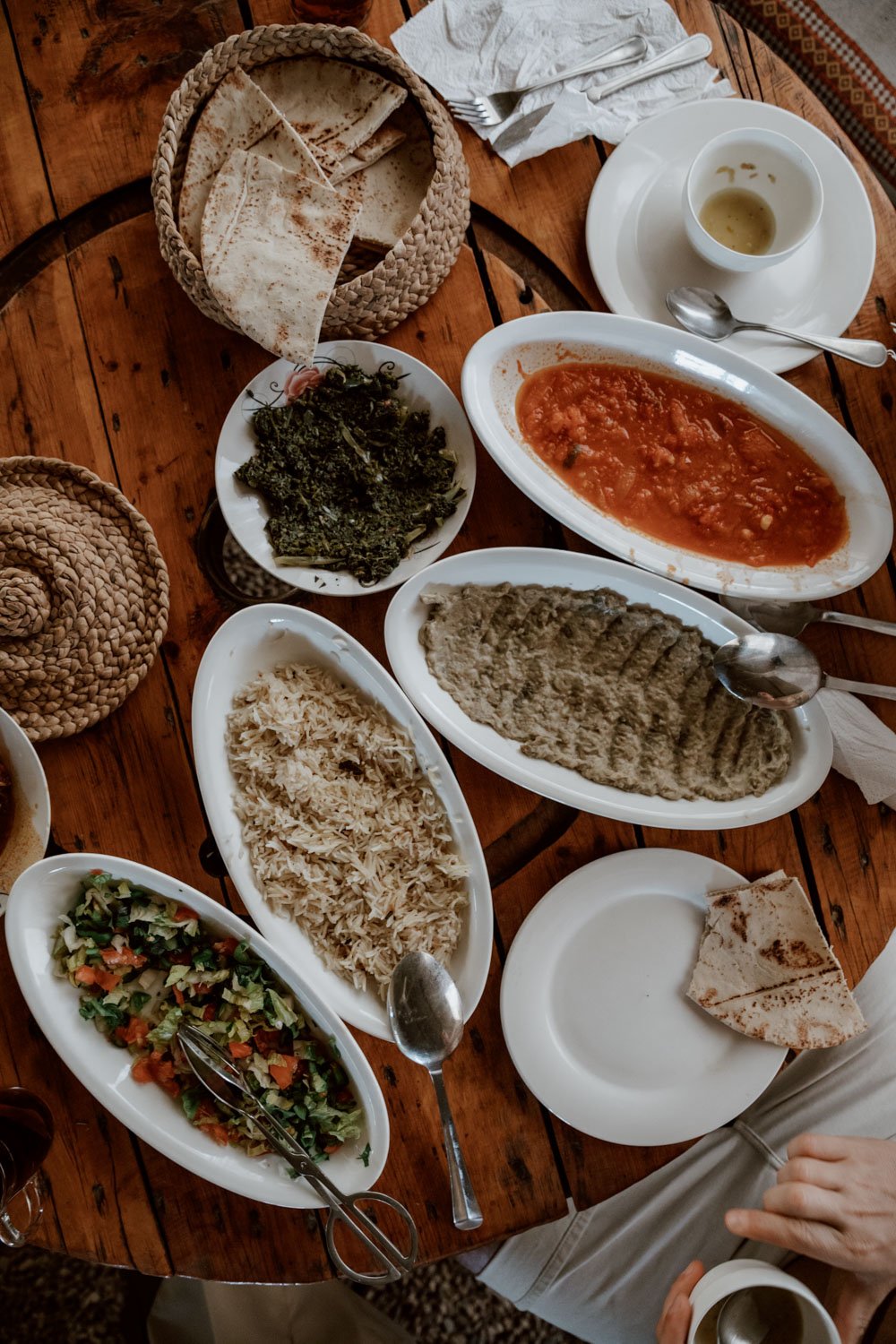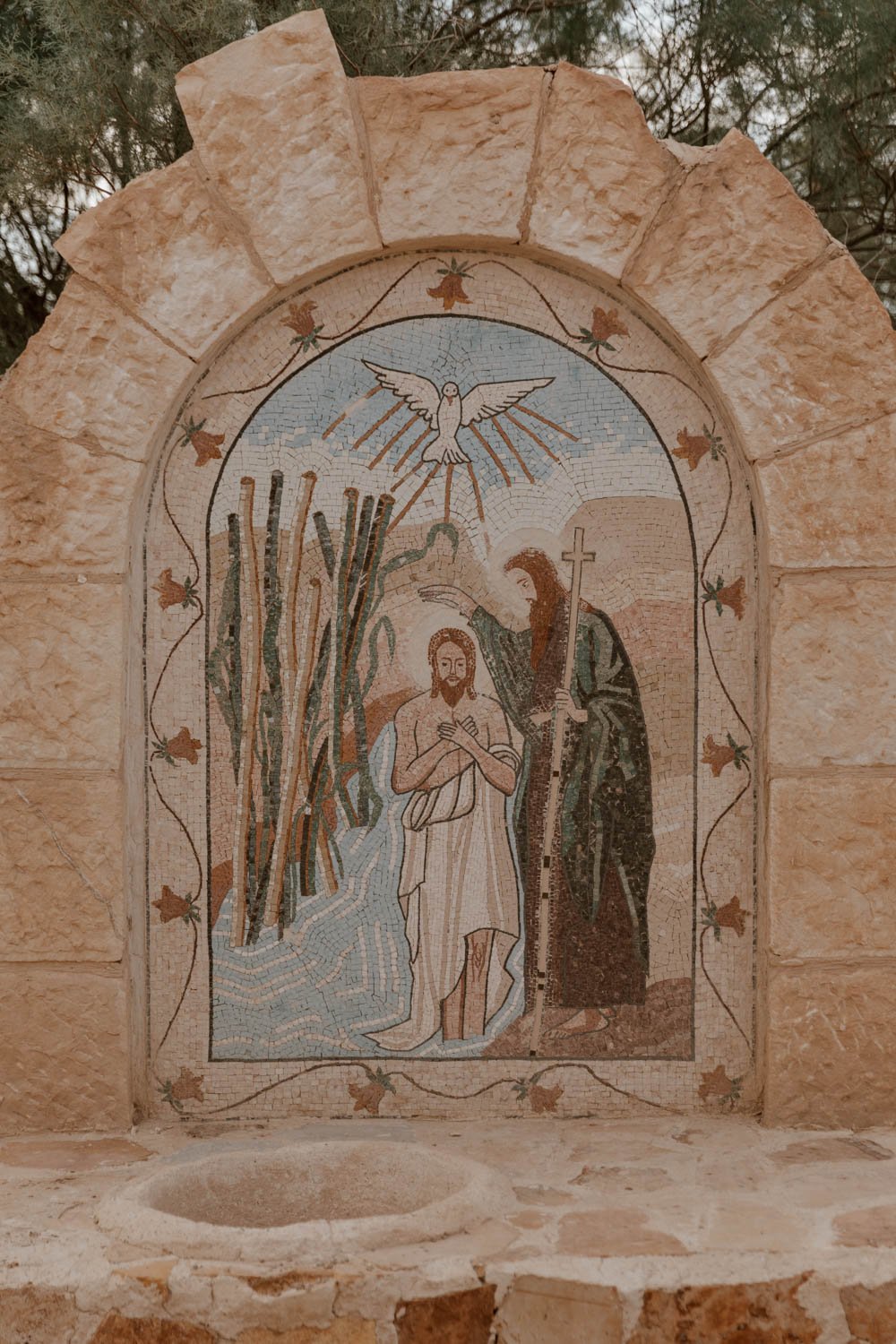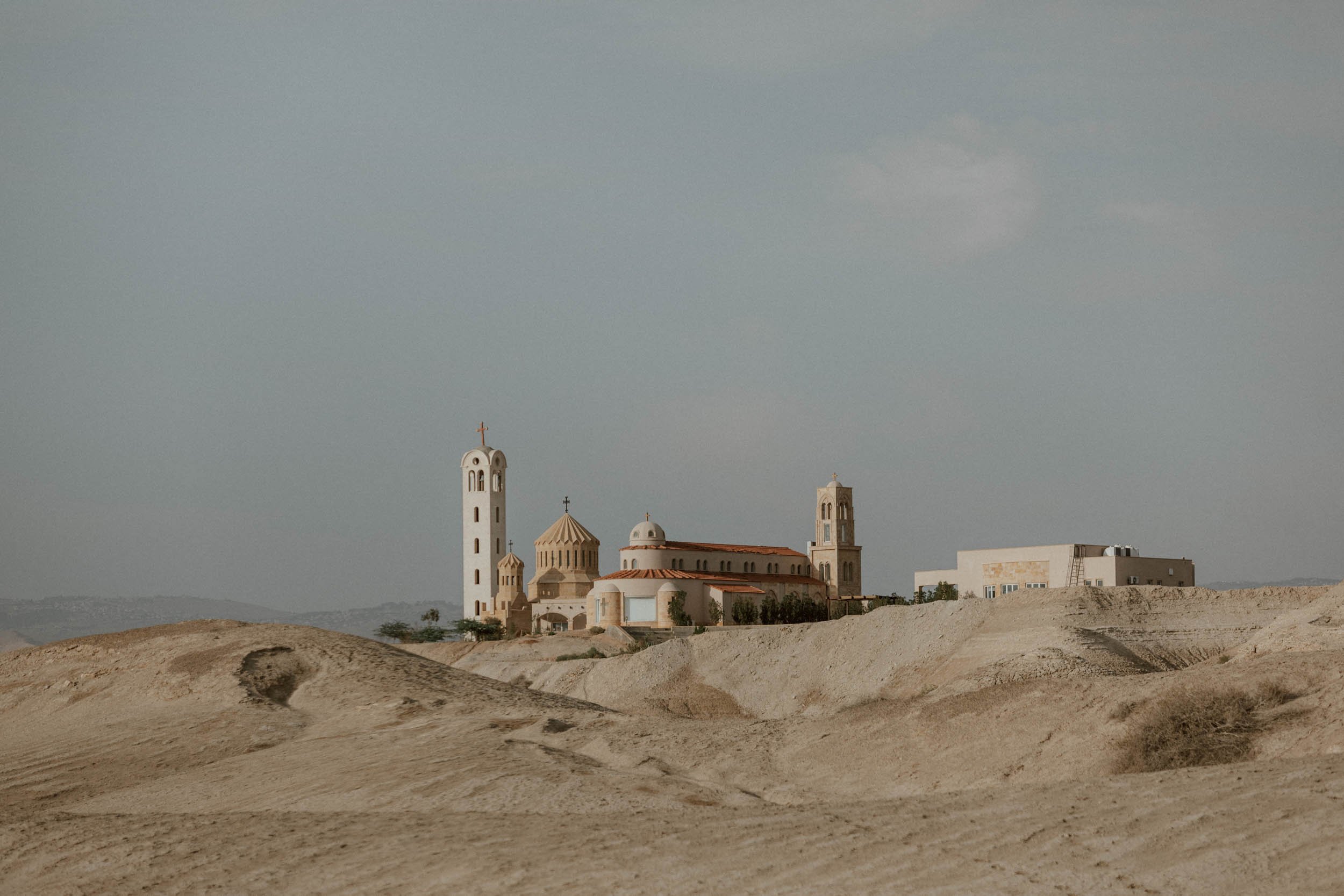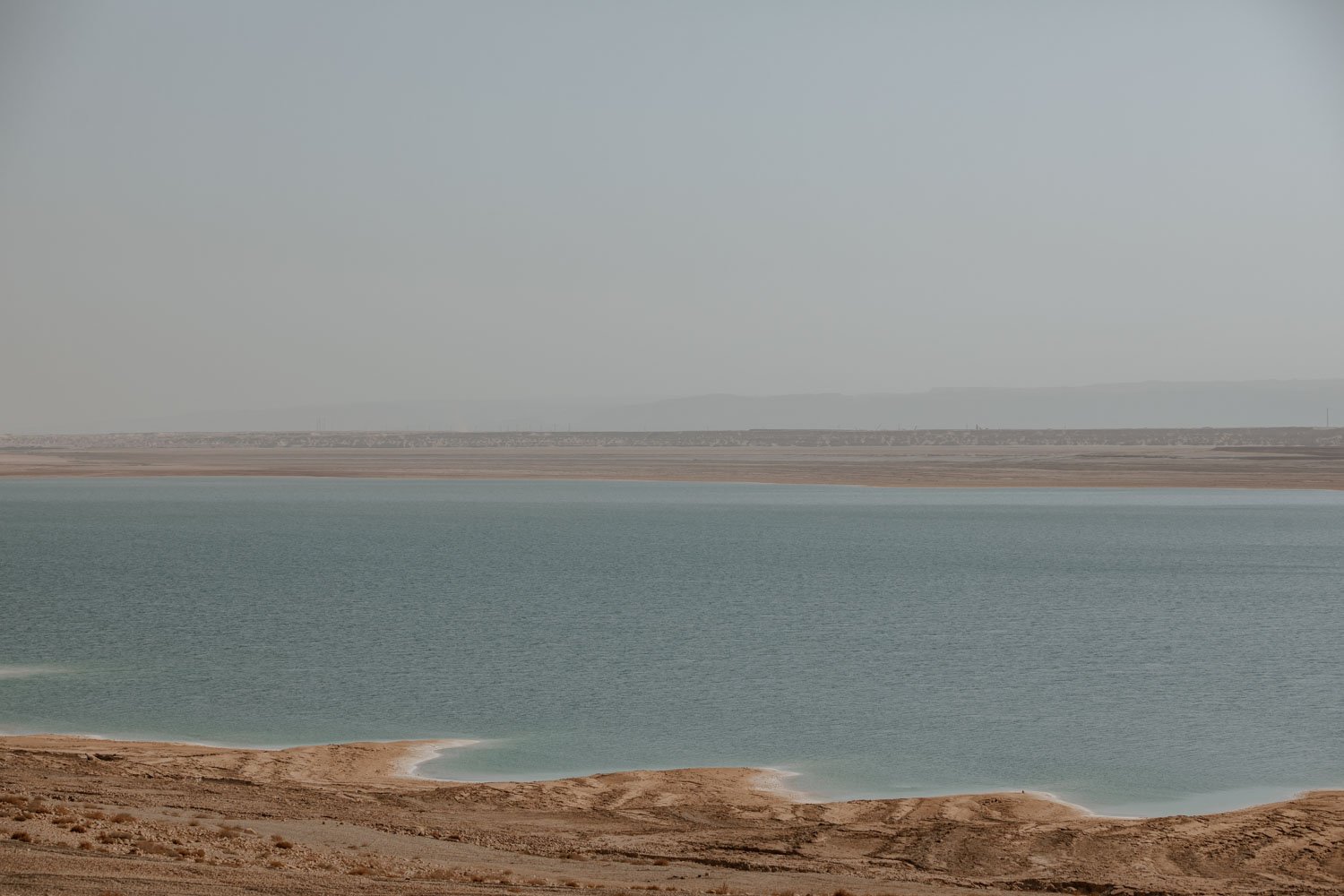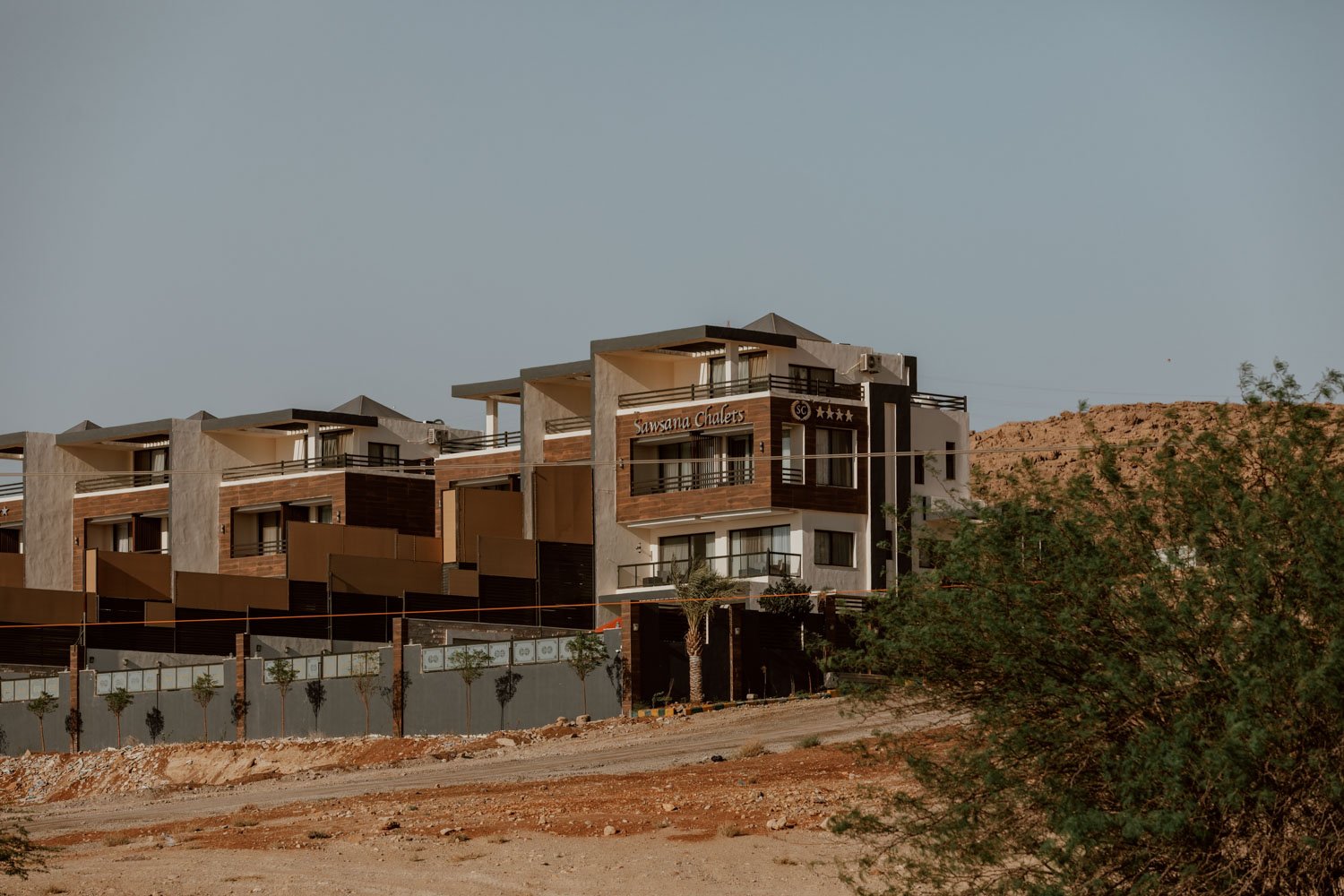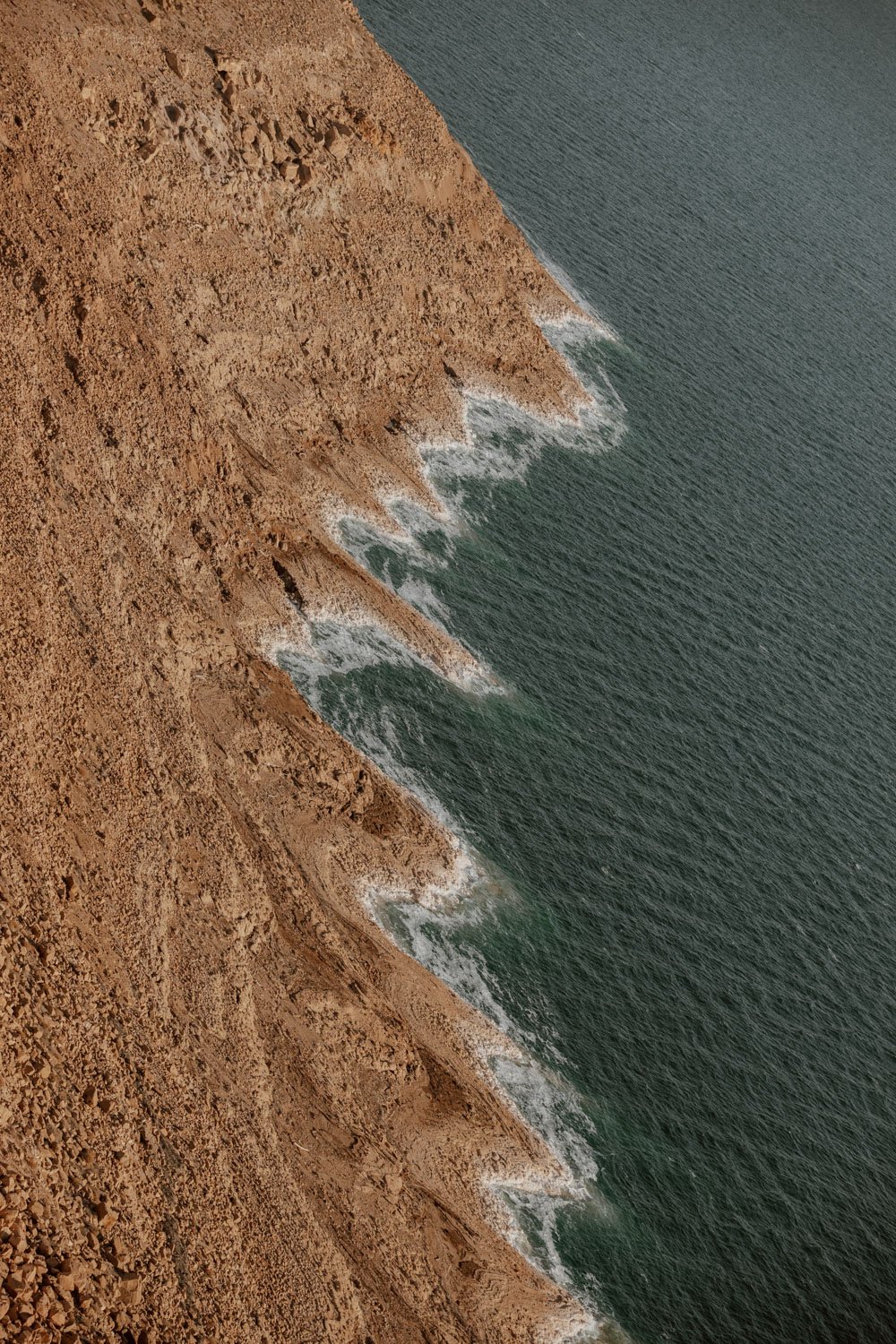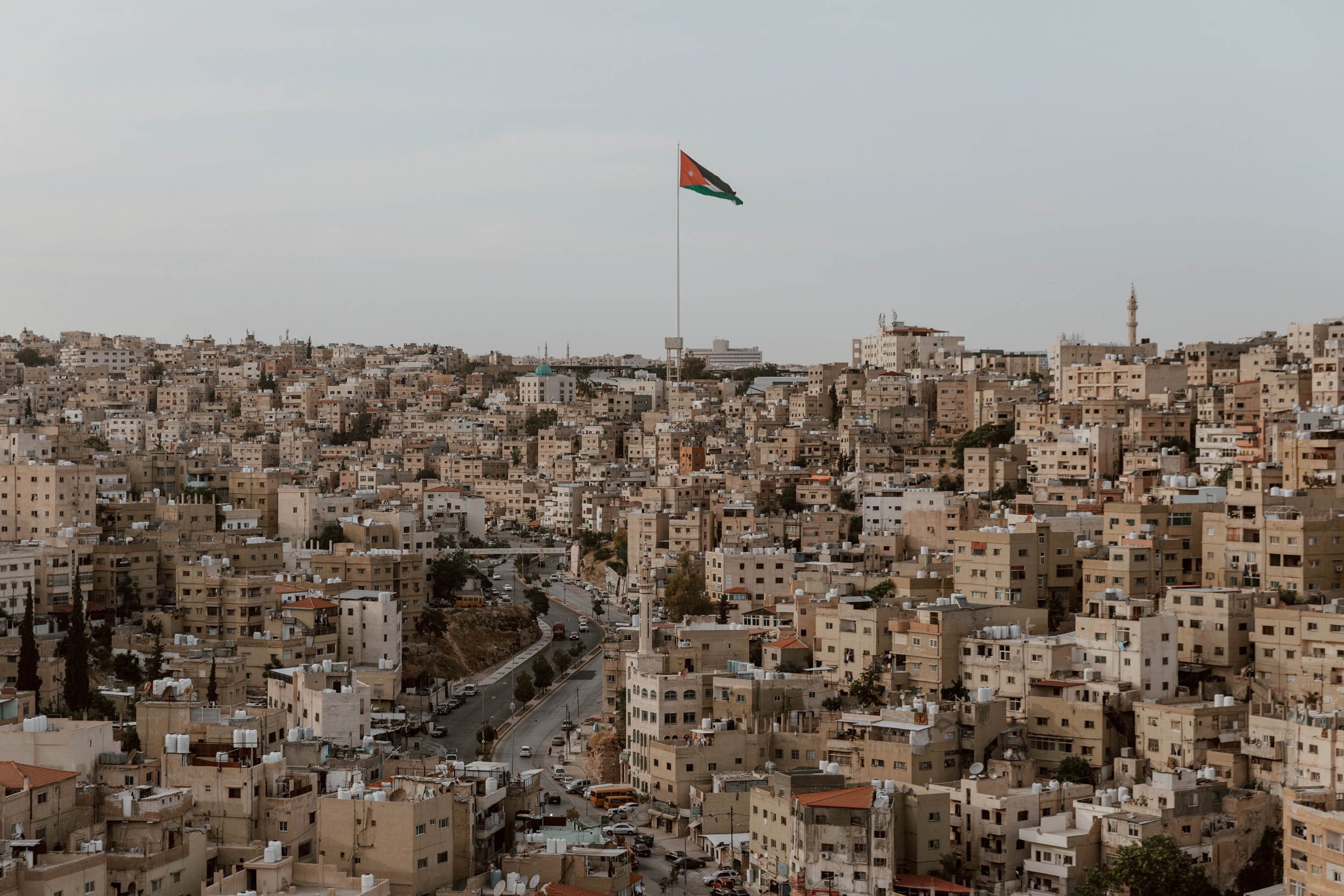Whether you stay at a fancy resort or opt for a local spot along the coast, floating in the Dead Sea is an integral part of every Jordan itinerary.
In this definitive guide, you’ll discover everything you need to plan your visit.
Updated October 2023
Located at 408m below sea level, the Dead Sea - so called for a salinity so high that no life can exist within its depths - is the lowest point on Earth; floating atop its surface is an absolute must do for any visitor to Jordan.
In fact, whilst our entire trip seemed to be filled with bucket-list moments, it was experiencing the weightlessness of the Dead Sea that Emily was most looking forward to!
If you’re ummmming and ahhhhing about whether to include the Dead Sea in your itinerary, we say just do it. This incredible quirk of nature has existed for millions of years (four million to be precise), but a combination of dams in the Jordan River, the potash industry and climate change mean that this 600+ square kilometre expanse of salted water may well disappear entirely in the next fifty years.
In a cruel twist of nominative determinism, this shrinking body of Biblical water will one day cease to exist.
In this article, we’ve shared the four main options to experience the Dead Sea, tips on swimming + floating in the lowest place on earth, essential advice on what to pack and how to prevent the salt causing health issues, plus tips on the best accommodation and other nearby places to visit before / after you visit the Dead Sea on a day trip!
This is our traveller’s guide to visiting the Dead Sea in Jordan.
the Dead Sea essentials
Fact / 408m below sea level
Where / In west Jordan, marks a border with Israel.
How / Easiest to access at one of the many resorts
Stay / For true luxury consider Kempinski Hotel Ishtar Dead Sea but other great alternatives include Mövenpick Resort & Dead Sea Spa Hotel
Other / Several free ‘swimming spots’
Visit / Easy day trip from Amman or Madaba either with your own vehicle of a tour (like this one)
Combine / Near biblical sites and Wadi Mujib
How to Visit the Dead Sea, Jordan
Despite the Dead Sea being one Jordan’s most popular attractions, knowing exactly how to access and properly experience it can be a little confusing when you start planning your trip.
Although the Jordanian part enjoys about 50km of shoreline with a highway running alongside it, much of it is fenced off, private, or simply inaccessible: navigating and knowing where you can safely and legally access with your own car isn’t very obvious.
Due to cultural norms and the type of facilities available, it’s also not somewhere you necessarily come and sunbathe for the day (unless you're getting a day pass or staying at the tourist-focussed hotels by the shore with private beach access).
The high salt levels can also pose serious issues if you don’t prepare ahead.
However, once you know how, the Dead Sea offers up an unforgettable moment to once-in-a-lifetime floating experience in the lowest place on earth. With the exception of Aqaba in the south, it’s also one of Jordan’s best suited destiations for a ‘holiday’ moment in the heat for those looking for some R&R between adventures, with mudpack and spa moments with the famous nutrient-rich products of the waters.
You’ve got four options which you can prioritise or blend together to experience the Dead Sea:
1/ Stay in a Dead Sea Resort
The most accessible areas of the water - and those that allow you to indulge in the ritual of the famed Dead Sea mud mask - are part of the many luxurious resorts clustered together at the northeasterly end of the shore.
In addition to providing private access to prime sections of the Dead Sea and its nutrient rich mud, they also offer world-class spa treatments, a pleasant holiday vibe, sunbathing areas and swimming pools, and a place that women can feel a little more comfortable in their swimwear.
For certain types of travellers, these modern franchise hotels and resorts offer an ideal place to relax and recalibrate before or after an action-packed schedule of walking the hills of Amman, hours spent exploring Petra in the heat, and camping in the Wadi Rum desert.
Before booking though, it’s important to be aware that prices are generally significantly higher than you’d find across the rest of Jordan, and you should expect to pay from £150 to £400 a night depending upon time of year and room type.
Unfortunately, this price tag doesn’t always equate to quality or 5* experience, with a premium added to these hotels due to their unique location and access to the Dead Sea. Therefore, it’s super important to read reviews and set your expectations accordingly.
Our top picks include:
Luxury | Kempinski Hotel Ishtar Dead Sea
Mid-range | Mövenpick Resort and Spa
Budget Friendly | Dead Sea Spa Hotel
Also, a friend of ours stayed for five days in the Hilton Dead Sea Resort and said she’d recommend it.
Note that there are little to no alternative types of accommodation available on or close to the water except the cluster of Dead Sea Resorts and the new Mujib Chalets (which are in a wonderful setting). Thankfully, if the resorts don’t chime well with your travel style or budget, there are alternative ways to explore and enjoy the area!
2/ Visit a Dead Sea Resort with a day pass
If you love the idea of private beach access and a more relaxing Dead Sea experience but don’t have the time - or the cash - to stay overnight, the good news is that almost all the resorts offer day passes to visitors (the only exception is the super luxurious Kempinski, where facilities are for staying guests only).
This permits you to access the private beach and most or all of its associated facilities (i.e. sunloungers, mud pools, swimming pools). It doesn’t however allow you to have access to the hotel itself, its spas, or - in the case of some of the more expensive options - all the swimming pools.
Day pass prices vary considerably between resorts, with the cheapest (Dead Sea Spa Hotel) costing around 20 JD per adult and then increasing to as much as 40 JD per person for the Marriott. Prices also increase at weekends and food will always be charged in addition.
There is no need to book your Dead Sea day pass in advance, but we would recommend contacting the resort to confirm prices.
If you’re visiting the Dea Sea on a day trip tour, it’s important that you confirm with the tour provider in advance whether your day pass is included in the price - for example, this one includes it whereas this one doesn’t.
Travel Tip // During your Dead Sea travel planning, you may come across ‘Amman Beach’. Whilst technically a public beach, it still charges a fee to access (around 20 JD). The online reviews are really quite abysmal (dirty, full of litter, broken chairs etc), however when we visited, the beach was cordoned off so we were unable to confirm or make our own judgement.
Our research makes us think it’s definitely not worth the money but, if you do visit or find it open, we’d love to hear your opinion in the comments.
There is also no ‘Dead Sea beach’, in the sandy sense, outside the man-made areas belonging to the resorts.
3/ Visit free swimming spots along the sea shore
If you don’t have enough time to make a relatively expensive day pass worth it or would rather not shell out for one at all, the good news is that there are various places to access, swim, or float in the Dead Sea for free all along the coast!
Indeed, this is what most locals do, and is the reason why you’ll see stalls selling gallon tanks of water at the side of the highway, alongside various groups of semi-naked men covered in mud.
Some of these spots are a little more difficult to access than others, but most simply require a little pre-planning and prep, and of course, your own vehicle. Most have little to no facilities too, so it’s 100% necessary for you to bring a few items in particular.
We’ve shared our favourite free Dead Sea swimming spots - including how best to visit them and what to bring - and specific driving advice later in the post.
Plan | 17 Essential Things To Know Before Renting A Car in Jordan
4 / A Dead Sea Day Tour
If you won’t be renting a car and driving in Jordan, and a stay at one of the Dead Sea resorts doesn’t suit your plans, then the final option is to opt for a Dead Sea tour from elsewhere in the country.
Public transport to/from the Dead Sea is limited to non-existent, so for most travellers using Amman for a base and doing day trips out of the capital city, the easiest way to visit the Dead Sea is on an organised tour.
The most popular day tour involves a transfer to one of the exclusive Dead Sea resorts where you can access the private beach, the sea and the mud baths. Additionally, you’re usually able to pay an extra fee to access all areas of the hotel as well as enjoy a lunch.
There are two super popular private tours, both with excellent reviews offering this day trip experience: this one and this one.
Alternatively, you can join a tour which encompasses the Dead Sea alongside other popular destinations in the area: this tour includes Madaba, Mount Nebo, and the Dead Sea, alongside a visit to some of Amman’s biggest attractions. This would be an excellent option if you want to squeeze in a lot in a short period of time, but may not be suited to slower travel styles.
If you’d prefer to combine a trip to the Dead Sea with Jerash, consider this option instead.
Lastly, if you’re based in the southern city of Aqaba, then this is a good day trip tour option: Wadi Al Mujib and Dead Sea Panoramic Tour.
tips for FLOATING in the Dead Sea
The first, and perhaps most salient point, is that you cannot actually ‘swim’ in the Dead Sea: the high salt count means that those that venture into the water will simply float atop it.
If you try and do any sort of breast stroke or front crawl, you legs will shoot up in the air, your head will submerge and you’ll get a big faceful of the saltiest water you’ve ever encountered! You really don’t want that.
So, it’s important to dispel that notion first: you are coming to float, not swim in the Dead Sea.
Due to the unique levels of salinity - something that none of you will have experienced elsewhere - simply being in the water here also requires a bit of advance planning. Otherwise, your skin, eyes, and nostrils will be in for a pretty rough ride…
If you’d like to learn more about the geological formation, unique composition, and threats facing the Dead Sea, we recommend taking a read of this article by The Smithsonian.
Be sure to wash off properly | Whilst the water will evaporate from your skin in the air, if you don’t wash off upon exiting the sea, you’ll be left with a crusty residue from the salt all over your body, hair and bathing suit. If visiting one of the resorts, there will be showers available nearby, but for those visiting one of the free spots, you need to bring bottles of water with you (we explain more about this later).
A little tip from Andrew - be sure to wash off ALL of your body, including ‘down there’! The salt has a way of clinging to your entire body, and some..sensitive areas..may sting more than others.
Don’t get water in your eyes or mouth | Whilst it won’t result in any long term damage, splashing a little of the salty water into your eyes will hurt like hell. If it happens, head to the shore immediately and wash you eyes out with clean, bottled water until the pain subsides.
The same goes for your mouth: swallowing a small amount isn’t dangerous, but it’s definitely unpleasant: just stay on your back, with your head above the water at all times and you should be fine.
Avoid Shaving Before | As careful as you may try to be with that razor, each time you shave your body you create little micro-cuts; you won’t even notice them, but good lord will they sting when coming into contact with the salty water! Ideally, you should avoid shaving for 2-3 days before you plan on taking a dip.
Further to this, if we say that freshly shaved legs can sting, how much would an open cut hurt? The answer is, an awful lot! However, you probably haven’t come all the way to Jordan to have that graze to your knee stop you floating in the Dead Sea. Whilst it isn’t a full-proof method, covering up any cuts with a good quality waterproof plaster or dressing would hopefully allow you to enjoy that bucket-list moment with minimal pain.
What to Wear | Shoes and bathing suits / swim shorts.
The salt rocks and crystals that form the edge of the coast are very sharp and unforgiving so wearing a pair of sandals or water shoes is essential for the walk down and out of the water. From personal experience, we would however recommend not using any shoes you’re particularly fond of - we both have a pair of Birkenstocks that have never quite recovered! You can take the shoes off in the water or leave them on the shoreline for exit.
In terms of clothing, it’s generally advised that you stick to dark colours and we’d recommend not wearing a brand new swimsuit / a personal favourite. This is especially important if you plan on enjoying the healing properties of the Dead Sea mud - a white swimming costume will look far from its best once you’ve gotten filthy. We didn’t personally experience any issues with the salt water discolouring our swimsuits, but had packed older ones intentionally.
Keep an eye on the time | The generally accepted advice is that you shouldn’t really be staying in the water for longer than 10 -15 minutes at a time. You can go in it more than once though!
Clean everything | The salt has the ability to find its way into everything you took down to the water’s edge with you, so absolutely everything will need a little wash or post-dip clean up. This includes all your tech to prevent any long term damage caused by salt crystals getting into nooks and crannies they shouldn’t.
Travel Tip // We used our 10 litre Ultradry bag to store our phone, cameras, and car keys. We bring this on most of our travels, and it’s an affordable, multi-use piece of kit. In Jordan, it was essential for our Wadi Mujib canyoning experience, which is right by the Dead Sea.
Free Swimming in the Dead Sea
Thankfully, for those who’d prefer to save the pennies, there are a small number of free swimming spots located along the coastline - some obvious and easy to reach, others that require a little more of a scramble, or have hidden access points that may not be immediately obvious.
Best Free Dead Sea Swimming Spot
We spent a good few hours driving up and down the highway, following a string a dots on Google Maps to locate the best Dead Sea swimming spots for you - and think we found it!
Handily located very close to the Wadi Mujib Adventure Centre, this spot is easily accessible to those with a rental car.
Simply make your way here on Google Maps, where you’ll find a good-sized dusty car park, from which it’s a five minute walk down to the edge of the water. Unlike several other spots, where you are required to park relatively high above the water and then scramble down a very steep dusty trail, this access point is fairly easy (though still on a bit of an incline).
Rather than a single swimming spot, this is actually a collection of five or so inlets, meaning that outside of the weekend, you can enjoy a relatively peaceful time separated from other visitors.
Expect to find a good mix of foreign tourists and locals.
Alternative Free Swimming Spots
Whilst the above place is absolutely our top recommendation for a free swimming spot at the Dead Sea, there are two others that we wanted to note here:
Noted on Google Maps as ‘Dead Sea free hot springs’ (here), this is probably the most popular free swimming spot with locals, as evidenced by several stalls selling bottled water, drinks and snacks, plus the number of cars parked up on the side of the road.
It’s also one of the only places where you can find mud pits outside of the resorts.
Unfortunately, this popularity comes with its disadvantages - specifically litter, broken glass, and a somewhat unpleasant experience for any girl who wishes to enter the water in a swimming costume. Emily didn’t feel at all comfortable there, but if you are travelling in an all-male group and fancy enjoying a free mud bath, this may be a good option.
Our second option is labelled on Google Maps as ‘Salt Beach’. There are actually several locations with this particular label, but we think that this was the corresponding spot. As the name would suggest, this is actually a small beach, but instead of sand, the cove is composed entirely of salt - it’s really quite incredible. The only difficult thing is that the access is a little tricky, with a much steeper, more precarious walk down; it’s the reason this isn’t our number one recommendation. An enterprising chap has even set up a small shower in the parking area for 2 JD per person!
If you find any other that are worth a recommendation, or circumstances change for the above, do let us know in the comments.
Free Swimming Spot Tips
Bring Your Own Water | The most important thing to be aware of if you’re hitting up one of the free Dead Sea swimming spots rather than the resorts, is that you need to bring your own water to wash the salt off.
You may come across an ingenious local that has set up a rudimentary shower system at some of the locations, but there is no guarantee that it will be functioning, or there won’t be a queue.
Lots of nearby shops and various stalls along the Dead Sea highway will sell large 10 litre bottles of water for 2 JD each; we found one of these bottles to be enough for both of us to adequately wash with. It is a tremendous waste of water, and we’re aware of the irony of using up bottled water like this in such an environment, but bringing one with you is essential if you want to float.
Change in the Car | No, it’s not elegant, but changing in the car - as opposed to on ‘the beach’ - is a must do for this adventure.
Dress Accordingly | Whilst female tourists are able to wear pretty much what they like within the resorts, this is absolutely not the case at any of the above mentioned free swimming spots. Avoid bikinis entirely, and opt instead for a conservative swimsuit, then when you get out of the water, have a cover-up handy that you can throw on.
It still probably won’t be enough to prevent unwanted male gazes though…
Go Before Dark | We really wanted to experience the sunset, and were the last to leave the shore. As wonderful as that was, it meant we really struggled to find out way back on the correct direct path and an easy way up to the car park, with only our mobile phone torch for light. We did eventually make it (finding the car in the pitch black was actually the most difficult part and caused a wee bit of a panic for one half of ADR), but do sincerely recommend that you get up and out before darkness descends.
Leave No Trace | Access to these spots remains free and open, and it’s essential for every traveller to act responsibility. Take back all your rubbish and don’t destroy or remove the hardened salt.
Read Later // 13 Wonderful Things To Do in Jordan
Things to Do in the Dead Sea
Whilst the most popular things in Jordan’s Dead Sea are staying at a fancy resort, experiencing the feeling of weightlessness in the water, and plastering yourself in mud, its location in western Jordan means you’re close to several other enjoyable activities.
This includes a three of our best things to do in Jordan, one of our favourite restaurants, and various photogenic viewpoints.
If you’re staying in a hotel, or you’re here visiting with your rental car, we recommend you make a whole day trip out of it and tag on at least a few of the below.
Drive the Dead Sea Highway
A scenic stretch which runs almost the full length of the water, we drove up and down it several times to enjoy various viewpoints and stops along the shore.
There is at least one military checkpoint on the road, so just follow the advice we share in 17 Essential Things To Know Before Driving in Jordan.
Travel Tip // The drive up and down the Dead Sea shoreline is about 100km, and there’s only fuel stations at the northern and southern extremities. Whether you’re visiting on a day trip from Madaba or Amman, or travelling south to Petra, we recommend arriving at the Dead Sea with a full-ish tank and/or filling up before you set off anywhere else.
Take in the View from Mount Nebo
Towering 1,000 meres above the desert and dry farmlands below is one of Jordan’s most important Christian holy sites, Mount Nebo. Known locally as Siyagha, it is the highest point of the ancient kingdom of Moab and where Moses, according to the Old Testament and scholars that have followed, was granted a view of the Promised Land - and where he died soon after.
A place of pilgrimage for early Christians from Jerusalem, a small church was built here in the second half of the 4th century to commemorate the life and death of the man regarded as a prophet by all three Abrahamic religions.
And whilst much has changed, been reconstructed, and redeveloped at this site in the intervening 1,600 years, Mount Nebo’s religious and historical significance remains, as does the opportunity to cast your eyes across that very same view.
Though an important pilgrimage site first and foremost, particularly for Christians, there is also enough here to interest the non-religious traveller, with the spectacular mosaics residing within the walls of the ancient basilica some the best presented you’ll see in the country (better lit and presented than those you’ll see in Madaba).
Mount Nebo is located a short, photogenic drive from the Dead Sea highway so is easily accessible for those with a rental car. Entry is not included within the Jordan Pass, and instead costs 3JD per person.
If you’d like to find out more, or are looking for help in planning your own trip out to Mount Nebo, be sure to take a look at our ‘Complete Guide to Visiting Mount Nebo’
Go Canyoning in Wadi Mujib
Whilst Wadi Rum is the most famous of Jordan’s ravines, there are a number of other wadis scattered across the country, including the popular adventure playground of Wadi Mujib Biosphere Reserve.
Extending from the heights of the Karak Mountains down to the Dead Sea, this 212-square-kilometre gorge is known as Jordan’s Grand Canyon and is home to several seasonal and year-round rivers, as well as a whole host of trails that can be attempted by travellers.
The most popular trail is the self-guided and easily accessible two-kilometre Siq Trail; a veritable assault course of ropes, rocks and fast-flowing water.
After a relatively sedate couple of weeks on our Jordan road trip (at least physically), Wadi Mujib was a real highlight, offering a completely different experience that we absolutely relished - if visiting Jordan between April and the end of October (when the Siq trail is is open), be sure to add it to your itinerary!
As the visitor centre + car park is right by the Dead Sea highway, it’s a no-brainer to include it if you’re visit the Dead Sea during the season.
We’ve written an entire guide to Wadi Mujib, so recommend heading over there for full details and help on planning your own trip.
Grab Lunch at Al Numeira
If you’ve been following Along Dusty Roads or a while, you’ll know how important it is for us to visit small businesses and initiatives that are working to improve the lives of individuals within the countries we travel.
In Jordan, that place was Al Numeira Environmental Association.
Created to educate and support the community in managing local resources, they also provide sustainable tourism employment both in the form of tours, as well as their excellent little restaurant.
If you’re passing through the Dead Sea area we highly recommend aiming for a traditional lunch spread here - it was some of the best local food we had during our time in the country!
The Details // The restaurant is located towards the southern coast of the Dead Sea (about 20 minutes drive from Wadi Mujib). Find it here on Google Maps.
If you’ve got a spare afternoon in the Dead Sea area, you could consider joining one of their hiking or biking tours, or alternatively, if planning a longer period of time in Jordan, they also offer homestay and WOOF-ing experiences.
Enjoy the Sunset at Panorama Dead Sea Complex
Opened in 2006, the Panorama Dead Sea Complex offers incredible vistas over Jordan’s salty waters, and to Israel beyond. Particularly popular at sunset, there’s also an on-site restaurant for a special dinner with a view (although the views aren’t stellar).
The entry to the viewing platform costs 2 JD per person and includes access to the Dead Sea Museum which is full of exhibits that cover the geology, history and environment of the area. Visitors can also take the short 1.4 kilometre Zara Cliff Walk from the complex which highlights local flora and fauna.
The Details // The Panorama Dead Sea Complex can be found here on Google Maps. The museum is open from 9am to 5pm in the summer and 8am to 4pm in the winter. The viewing platform/restaurant from 9am - 11.30pm int he summer, and 8am - 10pm in the winter.
If you’d like to have dinner here, it’s highly recommended that you make a reservation in advance - this can be done via their official website.
Visit Bethany Beyond the Jordan
Even if you’re not particularly religious, it’s difficult not to be moved when visiting Bethany Beyond the Jordan, the proven site of Jesus’ baptism by John the Baptist.
Lost to the history books for centuries and, situated right up against the border of the controversial Israel-occupied West Bank, it was only possible to revive and safeguard it following the seismic 1994 Peace Treaty signed by Jordan and its neighbour.
Since then, it has re-emerged as one of the most important Christian pilgrimage destinations within the Middle East, been visited by Popes and Presidents, and was designated as a UNESCO World Heritage site in 2015.
Bethany Beyond the Jordan is located just 25 minutes from the Dead Sea, so is easily visited if basing yourself there for a couple of nights, on the way to or from the resort, or as part of a road trip around this region.
Note that tickets to Bethany Beyond the Jordan are not included in the standard Jordan Pass, however when purchasing the Pass in advance of your arrival in Jordan, you can include the site as an add-on at a cost of 8JD. Alternatively, tickets can be bought in-person at the Bethany Beyond the Jordan ticket office for 12 JD.
We’ve written a complete guide on how to visit Bethany Beyond the Jordan, so head on over there for further details and how to plan your time.
Relax at the Ma'in Hotsprings
Despite a jam-packed itinerary during our two weeks in Jordan, we didn’t quite find the time to visit Hammamat Ma’In Hot Springs, located in the hills above the Dead Sea.
For those with a little more downtime, or keen to relax and soothe those aching muscles after days of walking amongst archeological behemoths and bouncing about in the back of a truck in Wadi Rum, a few hours within the thermal pools waters of Ma’In will likely be just what the doctor ordered!
The Springs now form part of a luxurious resort - Ma’In Hot Springs Resort - and whilst some people choose to stay here and enjoy the area without time constraints, it’s perfectly possible to visit as part of a day trip from Madaba.
A day pass cost to the Springs costs 15 JD per person, which gives you access to the public pools or alternatively you can pay 38 JD which allows you to use the spa facilities at the resort as well.
Where To Stay at the Dead Sea, Jordan
Whilst many people who visit the Dead Sea choose to stay in one of several resorts in the northern section of the coast, there are a number of other accommodation options in the area, so we have covered these here as well.
For the main and most popular Dead Sea resorts, note that they’re all clustered in and around the same area on the northern shore, rather than spread out along the sea.
Kempinski Hotel Ishtar Dead Sea | If money is no object, this is where you should stay. Offering a variety of stunning rooms and suites, its the amenities which truly set this hotel apart - the sea access is beautiful, there’s nine swimming pools, beautifully landscaped gardens and waterfalls inspired by the Hanging Gardens of Babylon, plus an incredible spa for all your pampering needs. The fact it doesn’t allow day pass entrants is also a pro for paying guests. Find out availability here.
Ma’In Hot Springs Resort | Those terribly relaxing hot springs that we mentioned above are part of a wonderful resort with an incredible backdrop, and staying there may feel a little more luxurious than some of the Dead Sea options. You would need a rental car though. Find out more here.
Mujib Chalets | Located near the entrance to Wadi Mujib, these isolated chalets (five in total, each with a terrace) are built facing the water and provide the most wonderfully private Dead Sea experience. There’s even private beach access. If we went back to Jordan, this is where we’d stay along the Dead Sea! Find out more here.
Dead Sea Spa Hotel | There’s no such things as cheap accommodation along the Dead Sea, but you can find the best value rooms here. Solidly affordable hotel with private beach and all the amenities you’d require for a pleasant stay. Seems to be popular with families. Find out more here.
Mövenpick Resort and Spa | Set across seven hectares of garden and falling somewhere between mid-range and luxurious Dead Sea resort, the 5* Mövenpick offers good-sized (if a little bland) rooms and excellent facilities including multiple restaurants, several swimming pools - even an infinity pool overlooking the sea - a private beach and a hotel spa. Find out more here.
How to Visit the Dead Sea From Amman
There used to be a JETT bus from Amman to the Dead Sea, but this has unfortunately been suspended indefinitely following a lack of usage, and whilst we don’t necessarily recommend hiring a rental car if basing yourself in Amman (driving into and out of the city can be a bit of a nightmare, and parking is tricky if not staying in a hotel with a private carpark), the journey from the capital to the Dead Sea is relatively straightforward, and can be done in around and hour to an hour and a half if you encounter only minimal traffic.
This means that for most people using Amman for a base and doing day trips out of the city, the easiest way to visit the Dead Sea is on an organised tour.
The most popular day tour involves a transfer to one of the exclusive Dead Sea resorts where you can access the private beach, the sea and the mud baths. Additionally, you’re usually able to pay an extra fee to access all areas of the hotel as well as enjoy a lunch.
There are two super popular private tours, both with excellent reviews offering this day trip experience: this one and this one.
Alternatively, you can join a tour which encompasses the Dead Sea alongside other popular destinations in the area: this tour includes Madaba, Mount Nebo, and the Dead Sea, alongside a visit to some of Amman’s biggest attractions. This would be an excellent option if you want to squeeze in a lot in a short period of time, but may not be suited to slower travel styles.
If you’d prefer to combine a trip to the Dead Sea with Jerash, consider this option instead.
Lastly, if you’re based in the southern city of Aqaba, then this is a good day trip tour option: Wadi Al Mujib and Dead Sea Panoramic Tour.
Where to Next?
13 Wonderful Things to Do in Jordan
11 Wonderful Things to Do in Amman
Our 10-Day Jordan Itinerary & Road Trip Planner
A Short Guide to Visiting Bethany Beyond the Jordan
A Complete Guide to Madaba | Jordan’s Mosaic City
A Short Guide to Visiting Mount Nebo
The Jordan Pass Review | Do You Really Need to Buy It?

